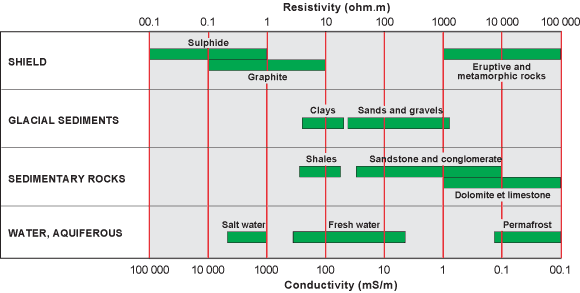The resistivity ![]() of a material is the physical property which determines the aptitude of
this material to be opposed to the passage of the electrical current.
The resistivity is the ohmic resistance of a cylinder of unit section
and length.
of a material is the physical property which determines the aptitude of
this material to be opposed to the passage of the electrical current.
The resistivity is the ohmic resistance of a cylinder of unit section
and length.
|
|
with: |
The usual units are the ohm for resistances and the
meter for the lengths. The resistivity unit will be thus the ohm.m. The
ohm.cm employed sometimes is value: 0,01 ohm.m. The conductibility
![]() is the reverse
of the resistivity and is expressed in mho/m. In hydrogeology we
generally employ the micromhos/cm or microsiemens/cm.
is the reverse
of the resistivity and is expressed in mho/m. In hydrogeology we
generally employ the micromhos/cm or microsiemens/cm.
![]() (ohm.m) = 10'000 /
(ohm.m) = 10'000 / ![]() (microsiemens/cm) = 1000 /
(microsiemens/cm) = 1000 / ![]() (millisiemens/m)
(millisiemens/m)

![]() Resitivity of different formations
Resitivity of different formations
Strictly speaking the Ohm law is valid only for metal conductors. For gas and electrolytes it is only an approximation.